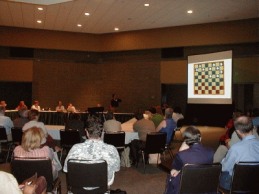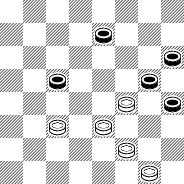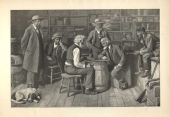The Checker Maven
The World's Most Widely Read Checkers and Draughts Publication
Bob Newell, Editor-in-Chief
Published each Saturday morning in Honolulu, Hawai`i
Contests in Progress:
Welcome to Checker School

Let's get started with a delicate endgame of a very practical nature. Class is in session!
WHITE

BLACK
Black to Play and Draw
Click on Read More for the solution, a runup to the position, and additional notes and quotes from Famous Positions.
(Editor's Note: the color diagrams will return as soon as we work through our article backlog.)
[Read More]Three Easy Strokes, Part Three
Here's the last of our "easier" stroke problems, at least in this series. Will you find this one to be a July cruiser, or something more? Solve it, check your solution by clicking Read More, and then prepare yourself --- next month's problem is going to be a summer scorcher.

WHITE
White to Play and Win
Two Easy Pieces: Sixth Edition
Willie Ryan's classic Tricks Traps & Shots of the Checkerboard, presented here in a new electronic edition, is up to the sixth installment. Here's what Willie has to say on page 16 of the book.
BLACK

WHITE
White to Play and Win
BLACK

WHITE
White to Play and Win
You can check your solutions by clicking on Read More.
[Read More]Checker-Go-Round

Click on Read More to check your solutions.
(We are always in need of speed problems. If you have any that you'd like us to publish, please contact us using the contact link in the left column.)
Problem 1. Very easy.
Problem 2. Easy.
[Read More]Fifth Reprise: Two Easy Pieces
Here is the fifth installment of our continuing series from Willie Ryan's classic Tricks Traps & Shots of the Checkerboard. As always, we're here to listen to the man himself; click on Read More to check your solutions.

White to Play and Win

White to Play and Win
The Last of the Masked Men
Our Masked Man problem series draws to a close with this month's article. We hope you've enjoyed it. Perhaps we can run another similar series sometime in the future.
If you can identify the problemist in the photo below, you're doing really well at this sort of thing.


WHITE
White to Play and Win
Can It Be Done?
Check your solution by clicking on Read More. Intended to be of "medium" difficulty, this one packs a surprise. Even if you solve it easily, though, by all means read the commentary which accompanies the solution.
[Read More]Three Easy Strokes, Part Two
We continue again this month with our "summer light" series of easier-than-usual stroke problems with this offering for June, which is, as you will see if you figure it out, a bit mis-labeled. And be forewarned, after this series concludes it's back to the hard ones!
After you solve it click on Read More to check your answer.

WHITE
White to Play and Win
It's Easy When You Know How
A recent addition to the library in our Santa Fe office is an item we've sought for quite some while: W.T. Call's Midget Problems, published in 1913. We think the following quotation from the preface to this little booklet is revealing:
'Are not these little problems easy?
'Yes, when you are looking at the solutions.'
Over the coming months we'll be featuring some selections from this work, which features nothing but problems with two pieces per side, hence the title, Midget Problems. But as the preface warns, these are small only in size, not in challenge.
We'd like to start out with an offering that you might consider trite; and frankly, we'd have to agree, yet there is a method to our madness. It is a setting of First Position, credited to Dr. T. J. Brown of Limerick, who put this forth around the year 1870.

BLACK
Black to Play and Win
And when you've worked through this setting (you can click here for an animation of Dr. Brown's trunk solution), answer this trivia question, also credited to Dr. T. J. Brown. What is the earliest published example of First Position? Can you name the author and year? If you can, you really know your draughts history.
But before you're done, tell us, if you can, what White's last move might have been, and then draw a conclusion from your answer. (Thanks go to Brian Hinkle for this one.)
As usual, click on Read More for the answers.
[Read More]A Tommie Wiswell Saturday Bonus!
As a special Saturday extra for our readers, we offer this Tommie Wiswell Prize Problem, which is actually somewhat easier than most Wiswell offerings, but certainly no less elegant.

WHITE
White to Play and Draw
Rush Hour

Click on Read More to check your solutions.
(We are always in need of speed problems. If you have any that you'd like us to publish, please contact us using the contact link in the left column. We are looking for problems that are much harder than the ones we've been publishing but still easy enough for an experienced player to solve in under five minutes.)
Problem No. 1. Very easy.
Problem No. 2. Easy.
[Read More]The Checker Maven is produced at editorial offices in Honolulu, Hawai`i, as a completely non-commercial public service from which no profit is obtained or sought. Original material is Copyright © 2004-2024 Avi Gobbler Publishing. Other material is the property of the respective owners. Information presented on this site is offered as-is, at no cost, and bears no express or implied warranty as to accuracy or usability. You agree that you use such information entirely at your own risk. No liabilities of any kind under any legal theory whatsoever are accepted. The Checker Maven is dedicated to the memory of Mr. Bob Newell, Sr.

